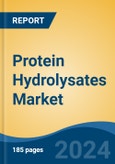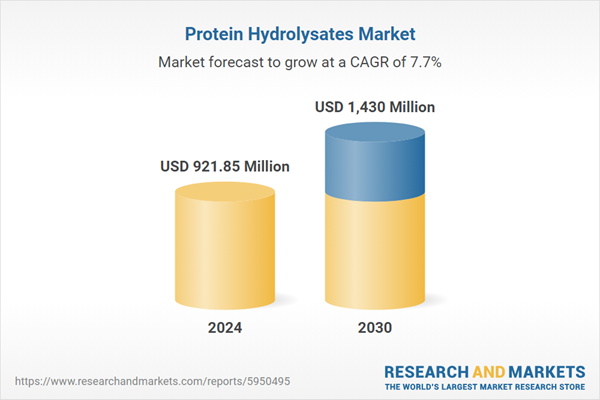Milk is the fastest growing segment, Asia-Pacific is the largest regional market
Speak directly to the analyst to clarify any post sales queries you may have.
10% Free customizationThis report comes with 10% free customization, enabling you to add data that meets your specific business needs.
Key Market Drivers
The growing global focus on health and wellness strongly drives the protein hydrolysates market, as consumers increasingly seek nutritional products that support overall well-being. This rising health consciousness fuels demand for ingredients offering enhanced digestibility, bioavailability, and functional advantages. Protein hydrolysates meet these expectations, integrating into various functional foods and beverages. According to Cargill’s 2025 Protein Profile, 61% of Americans increased their protein intake in 2024, up from 48% in 2019, illustrating this shift.The sports nutrition segment also plays a pivotal role in market growth, driven by athletes and active consumers seeking improved performance and faster recovery. The rapid absorption and reduced allergenic potential of hydrolysates make them ideal for pre-, intra-, and post-workout formulations. Growing plant-based protein consumption further contributes to diversification; the USDA reported an 11% rise in U.S. plant-based protein consumption from 2021 to 2023. Industry developments such as Tessenderlo Group’s 2023 joint venture with Hainan Xiangtai Group to expand fish collagen peptide production demonstrate ongoing innovation to meet evolving market needs.
Key Market Challenges
The volatility in raw material prices presents a major barrier to growth in the Global Protein Hydrolysates Market. Fluctuating costs of key protein sources, including whey and soy, create instability in manufacturing expenses and complicate long-term planning. This unpredictability increases production costs, erodes profit margins, and may delay investment in new technologies or product development. For example, the USDA reported U.S. whey protein concentrate output fell to 495 million pounds in 2024, a 1.9% decline from the previous year, highlighting supply-related pressures on production. As raw material costs rise, manufacturers may be forced to increase prices for hydrolysate-based products, potentially dampening demand across end-use sectors.Key Market Trends
The adoption of sustainable sourcing and production methods is increasingly shaping the Global Protein Hydrolysates Market, driven by rising environmental awareness and evolving regulatory expectations. This trend includes responsible raw material sourcing, reduced-waste manufacturing practices, energy-efficient operations, and transparent supply chains. According to the Good Food Institute, the number of companies in the fermentation sector - an important contributor to sustainable protein production - increased by 16% globally in 2023. Industry commitments to sustainability are further exemplified by initiatives such as the Q2 2024 partnership between Donaldson and PolyPeptide, which focuses on implementing solvent recovery technologies to reduce environmental impact in peptide manufacturing.Key Market Players Profiled:
- Kerry Group Plc.
- Nestle S.A.
- Arla Foods AMBA
- AMCO Proteins, Inc.
- Royal FrieslandCampina N.V.
- Fonterra Co-Operative Group Limited
- Parabel Nutrition Inc.
- Healy Group
- ADM Company
- Danone Trading ELN B.V.
Report Scope:
In this report, the Global Protein Hydrolysates Market has been segmented into the following categories:By Type:
- Milk
- Meat
- Marine
- Plant
- Eggs
- Others
By Source:
- Animals
- Plants
- Microbes
By Form:
- Liquid
- Powder
By Process:
- Enzymatic Hydrolysis
- Alkaline Hydrolysis
By Application:
- Animal Feed
- Infant Nutrition
- Clinical Nutrition
- Sports Nutrition
- Dietary Supplements
- Others
By Region:
- North America
- Europe
- Asia-Pacific
- South America
- Middle East & Africa
Competitive Landscape
Company Profiles: Detailed analysis of the major companies present in the Global Protein Hydrolysates Market.Available Customizations:
With the given market data, the publisher offers customizations according to a company's specific needs. The following customization options are available for the report.Company Information
- Detailed analysis and profiling of additional market players (up to five).
This product will be delivered within 1-3 business days.
Table of Contents
Companies Mentioned
The companies profiled in this Protein Hydrolysates market report include:- Kerry Group Plc.
- Nestle S.A.
- Arla Foods AMBA
- AMCO Proteins, Inc.
- Royal FrieslandCampina N.V.
- Fonterra Co-Operative Group Limited
- Parabel Nutrition Inc.
- Healy Group
- ADM Company
- Danone Trading ELN B.V.
Table Information
| Report Attribute | Details |
|---|---|
| No. of Pages | 185 |
| Published | November 2025 |
| Forecast Period | 2024 - 2030 |
| Estimated Market Value ( USD | $ 921.85 Million |
| Forecasted Market Value ( USD | $ 1430 Million |
| Compound Annual Growth Rate | 7.7% |
| Regions Covered | Global |
| No. of Companies Mentioned | 11 |









